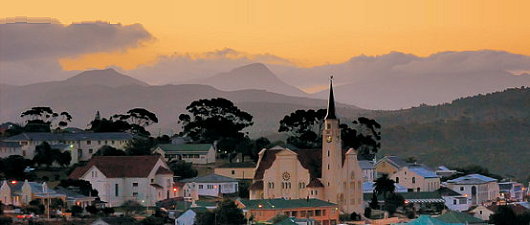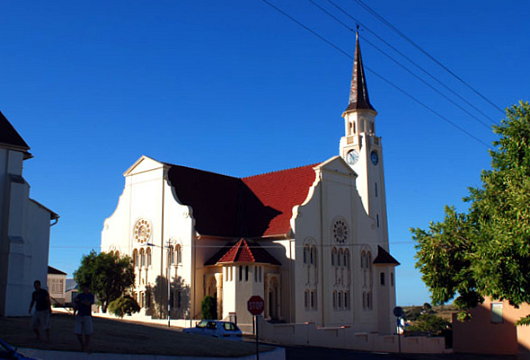
About Andrew Cusack
 Writer, web designer, etc.; born in New York; educated in Argentina, Scotland, and South Africa; now based in London.
Writer, web designer, etc.; born in New York; educated in Argentina, Scotland, and South Africa; now based in London. read more
News
Blogs
Reviews & Periodicals
Arts & Design
World
France
Mitteleuropa
Knickerbockers
Argentina
The Levant
Africa
Cape of Good Hope
Netherlands
Scandinavia
Québec
India
Muscovy
Germany
Academica

Napier in the Overberg
NESTLED IN the Overberg, the little town of Napier owes its existence to a dispute between two neighbours. In the earlier part of the nineteenth century, as the little farm villages of the Cape became more firmly settled, the Dutch Reformed synod had to choose which towns were deserving of their own church. In 1833, the congregation in Swellendam decided to build a church further south to meet the needs of its members there, but couldn’t decide between two locations. Michiel van Breda wanted the church sited on his farm, Langefontein, while Pieter Voltelyn van der Byl wanted it built on his property, Klipdrift. Neither van Breda nor van der Byl would give way, so churches were built in both places, the town of Bredasdorp growing around van Breda’s church and the town of Napier founded around van der Byl’s church.
The town is named after Sir George Thomas Napier, the Governor of the Cape from 1837 to 1844, but it is usually pronounced bi-syllabically, as “na-peer” rather than in its usual tri-syllabic English form. Napier has a wagon monument built in 1988 commemorating the hundred-and-fiftieth anniversary of the Great Trek, and the largest vertical sundial in the Cape, built by a townsperson in 1965.
The most prominent attraction in Napier, however, is the Dutch Reformed Church built in 1927. The architect was Wynand Hendrik Louw, one of the two most prominent early-twentieth-century proponents of an Afrikaans gees (spirit) in architecture — the other being his sometime business partner Gerard Moerdyk. He studied at Stellenbosch University as well as at the school of the Architectural Association in London.
In the course of his practicing years, Louw completed several buildings at Stellenbosch University, was co-architect of the Old Mutual building (the Mother City’s most famous skyscraper), and planned the handsome home of De Nederlandsche Club at Keeromstraat 16 in Cape Town. He designed dozens of churches for the Nederduits Gereformeerde Kerk, including this handsome example in the Overberg town of Napier.

Search
Instagram: @andcusack
Click here for my Instagram photos.Most Recent Posts
- Sag Harbor Cinema March 26, 2025
- Teutonic Takeover March 10, 2025
- Katalin Bánffy-Jelen, R.I.P. March 3, 2025
- Substack Cusackiensis March 3, 2025
- In the Courts of the Lord February 13, 2025
Most Recent Comments
Book Wishlist
Monthly Archives
Categories



Andrew …
The Overberg is my favourite part of South Africa. It is magic for me. I especially like the town of Bredasdorp. There is a great little newspaper from there: “Die Suidernuus”. But perhaps the most special place in the Overberg for me is Waenhuiskrans (Arniston). The Coloured fishing community live in a village right up against the sea. I used to stay at the Arniston Hotel at Waenhuiskrans before it became well known with overseas visitors and thus expensive. I would take a room with views out onto the southern Indian Ocean—breathtaking.
Whenever I am in the Cape I always head for the Overberg and I especially like to drive to Bredasdorp from Swellendam.
Thanks so much for posting about this wonderful place … ag, now you have made me homesick again.
Posted from Remuunj, Limburgia.
Ag, there’s so much in the Overberg! Waenhuskrans/Arniston/Kassiesbaai is significant enough being the town with three names, but it’s such a lovely spot as well. I want to buy the Overberg Toetsbaan and turn it into my own private coastal domain.
But there are a thousand brilliant little nooks in die Overberg: the Moravian missions especially come to mind. (Needless to say, there are posts on them in the pipeline).
Also, that strangely flat area as you drive down towards Agulhas strikes me as somewhat Netherlandic.
The Netherlands will surprise you, Mr Cusack, once you actually get there.
You should indeed come by someday Andrew.